
Recent Activity at the Pyongsan Uranium Concentrate Plant (Nam-chon Chemical Complex) and January Industrial Mine
Key Findings
- Commercial satellite imagery collected during the past eight months indicates that despite the absence of any nuclear testing by North Korea since 2017, the Pyongsan Uranium Concentrate Plant remains operational, is producing uranium concentrate (U3O8, “yellowcake”), and continues to be updated. Yellowcake can be enriched to become highly enriched uranium (HEU), which can be used to produce nuclear weapons.
- Most notable is the significant growth of the tailings pile up the valley north-northwest of the ore processing facility. While the tailings pile extended approximately 420 meters up the valley in June 2020, it had increased to approximately 505 meters by March 5, 2021. This indicates ongoing mining of uranium ore in the last two years.
- The Pyongsan Uranium Concentrate Plant remains the sole verified producer of uranium concentrate in North Korea. As such, it represents the foundation upon which the nation’s production of fissile material for nuclear weapons is built.
- Given the observed level of activity and North Korean statements concerning the development of nuclear weapons and ballistic missiles, and barring any unforeseen developments, the plant will undoubtedly remain operational for the foreseeable future.
- The dismantlement of the Pyongsan Uranium Concentrate Plant should be an essential component to any meaningful future “complete, verifiable, irreversible dismantlement” nuclear agreement between the United States and North Korea.
- Given known North Korean industrial practices, observed waste storage practices, and health and safety concerns raised by defectors and outside observers, there are likely to be numerous health, safety, and environmental issues surrounding the operations (and any decommissioning efforts) at the Pyongsan Uranium Concentrate Plant and its related facilities.

The Pyongsan Uranium Concentrate Plant
Since the closure of the Pakchon Pilot Uranium Concentrate Facility in the mid-1990s, the Pyongsan Uranium Concentrate Plant remains the sole verified producer of uranium concentrate (U3O8, “yellowcake”) in North Korea. As such, it represents the foundation upon which the nation’s production of fissile material for nuclear weapons is built.
Analysis of commercial high-resolution satellite imagery acquired from August 2020 through March 2021 indicates that the Pyongsan Uranium Concentrate Plant and its associated support areas, tailings pond, and uranium mining complex (January Industrial Mine) remain operational. Imagery shows the facility continues to be maintained, refurbished, or modernized. Given this level of activity and North Korean statements concerning the development of nuclear weapons and ballistic missiles, the plant will undoubtedly remain operational for the foreseeable future barring any unforeseen developments.
This report provides an update to Beyond Parallel’s reports on the facility published during May and August 2020. Readers are encouraged to read those reports for a more comprehensive appreciation of the development and operations of the facility.
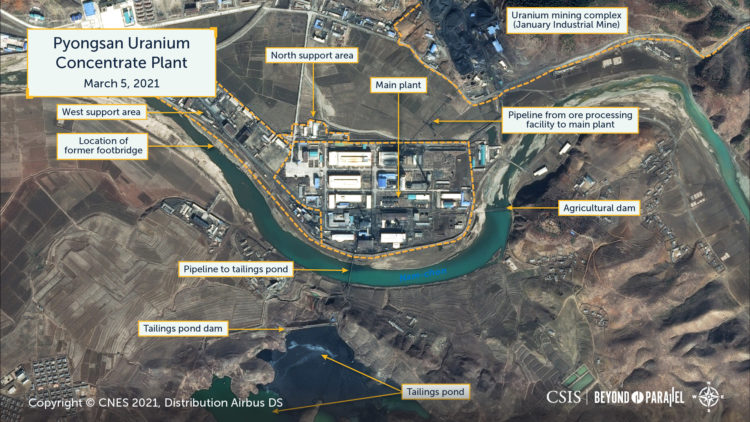
Main Plant
The main area of the Pyongsan Uranium Concentrate Plant continues to show activity associated with continued uranium concentrate production and ongoing modernization efforts.
Ongoing operations are observed at the leaching and classifying building. Notably, six of the eight open-air settling tanks on the north side of the building are full and two are partially full. The roof is once again showing signs of deterioration with some panels already in need of replacement. This deterioration is caused by acid vapor condensing on the underside of the roof panels.
The excavation/construction activity on the north and northwest sides of the sampling and grinding building discussed in our previous reports appears to be in its final stages. On the northeast corner of the building what appears to be three new open-air settling tanks (empty at present) or a small foundation and have been built. The roof of the building shows the continuing accumulation of dust from ongoing sampling and grinding operations.
The large waste storage facility immediately to the east of the sampling and grinding building has been rebuilt and appears to have a layer of solid waste along its bottom. Further to the east, the temporary opening in the northeast corner of the security wall now appears to be permanent. Immediately outside the east security wall is a small compound that has undergone minor development since our last report. The purpose of this compound is unknown.
Finally, in the southwest corner of the main plant, the internal support area has witnessed the rebuilding of the security wall and the addition of two small structures (likely greenhouses).

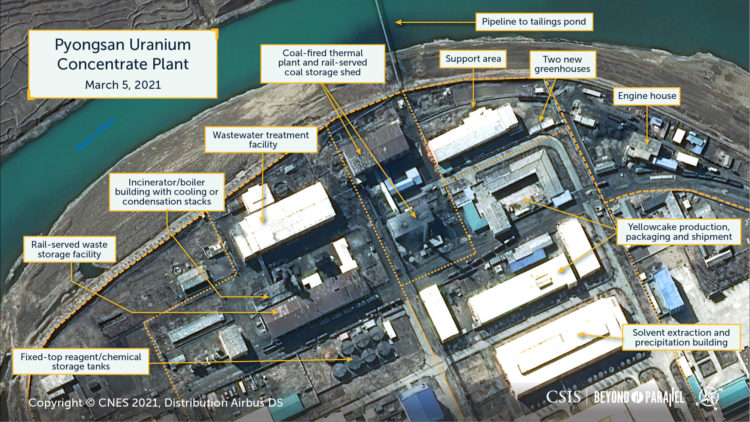
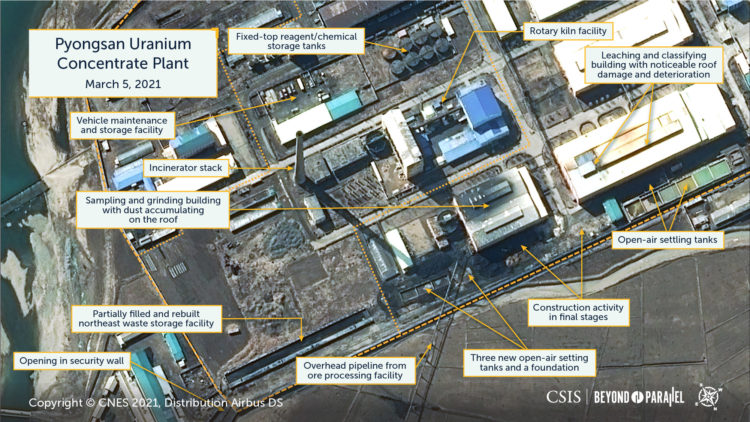
Support Areas
Only minor changes are observed in the west and north support areas since Beyond Parallel’s reports on the facility from 2020. Most notably was that the footbridge across the Namchon (Namchon River) between Pyonghwa-ri and the west support area was damaged and then washed away during the 2020 typhoon season.
Within the north support area, the only observable change of significance is the beginning of what appears to be a project to expand the transformer yard.
Railyard
A total of 27 railcars are observed within the railyard serving the main plant and west support area. This is only the second time that this high of a number has been present in imagery reviewed for the May 2020 and August 2020 reports. Of the 27 railcars present, 17 are tank cars (used to transport gaseous or liquid cargos) and 10 are gondolas (an open-top rail car used to transport mixed or bulk cargos including various types of ore or waste).

Tailings Pond
The tailings pond (more accurately a lake) located on the south side of the Namchon remains operational. Both precipitated solid and liquid waste continue to accumulate here. A slurry of solid and liquid waste is pumped from the wastewater treatment building in the main plant to the tailings pond via an approximately 380-meter-long pipeline. At the northeast corner of the dam, a pumphouse then distributes the slurry into the tailings pond via ditches or moveable pipes laid on the surface of the sediment or to a second pumphouse to the south. This second pumphouse then distributes the slurry further south into the eastern bays of the tailings pond. During the past eight months the ditches and pipes on the precipitated solid waste continue to shift, and the visible precipitated solid waste itself has continued to increase and now completely blocks five bays of the pond.

Agricultural Dam
Although the small agricultural dam immediately east of the main plant survived much of the 2020 typhoon season, a small breach on the west end of the dam developed during June-October 2020. How this will impact the overall integrity of the dam with the upcoming spring runoff and rains is unclear. The road bridge 170 meters downriver of the dam does not appear to have been seriously damaged during the 2020 typhoon season.
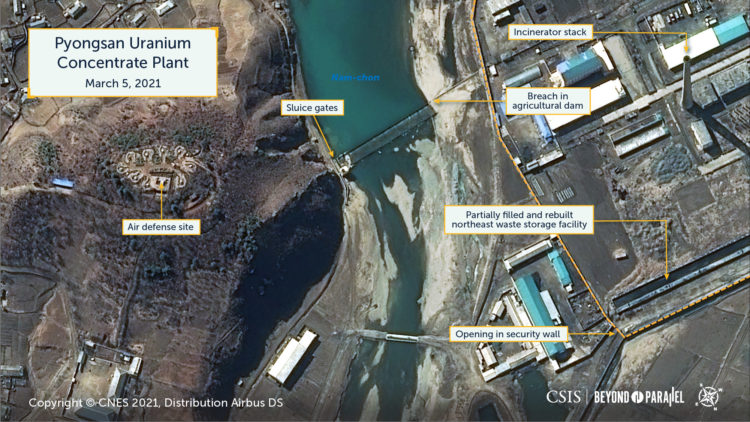
Uranium mining complex (January Industrial Mine)
Beginning approximately 600 meters to the northeast of the main plant and covering approximately 235 hectares is the Pyongsan Mining Complex (January Industrial Mine). Satellite imagery from August 2020 through March 2021 indicates that the complex remains operational, two of the original five mining shafts are operational, the tailings piles west and northwest of the ore processing facility continue to grow, and a number of minor miscellaneous changes (e.g., minor construction in the adjacent village of Panma, etc.) are noted.
Most notable is the significant growth of the tailings pile up the valley north-northwest of the ore processing facility. While the tailings pile extended approximately 420 meters up the valley in June 2020, it had increased to approximately 505 meters by March 5, 2021.
Shaft A: The headframe (i.e., the frame structure above the mine shaft used to raise and lower workers, equipment, and ore) was removed during early-2015 and the shaft abandoned.
Shaft B: Sometime between July 18, 2019 and September 13, 2019 the headframe for Shaft B was removed and the shaft is no longer operational. With the exception of erosion, no activity is observed on the adjacent tailings pile in the March 5, 2021 image.1
Shaft C: The headframe for the shaft remains in place and minor activity is noted on the adjacent tailings pile. As of March 5, 2021, Shaft C appears to be operational, albeit at a low level.
Shaft D: The headframe for this shaft was removed between early- to mid-September 2015 and it is no longer operational. With the exception of erosion, no activity is observed on the adjacent tailings pile. There has, however, been some minor activity in the support area immediately south of the tailings pile.
Shaft E: This shaft appears to be operational as the new headframe first observed during July 2018—the original having been removed between 2013 and 2017—remains in place. Sometime between June 2020 and March 2021 a new building was constructed adjacent to the headframe and changes to the tailings pile are noted since our last report. The very minor tailings (likely related to some minor exploratory or artisanal mining) approximately 175 meters northeast of Shaft E have changed slightly due to erosion during the 2020 typhoon season.2
Tailings/Storage Pile: Approximately 625 meters to the south of Shaft E is a tailings/storage pile. Minor changes are observed to the pile. However, it is unclear if these are due to small excavation efforts or simply erosion.
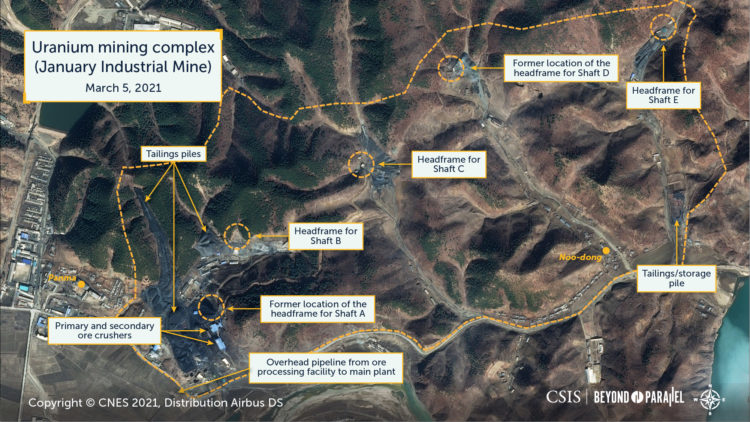
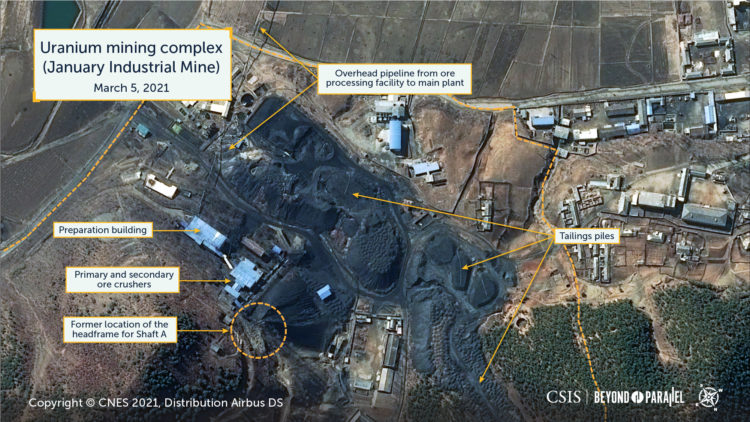

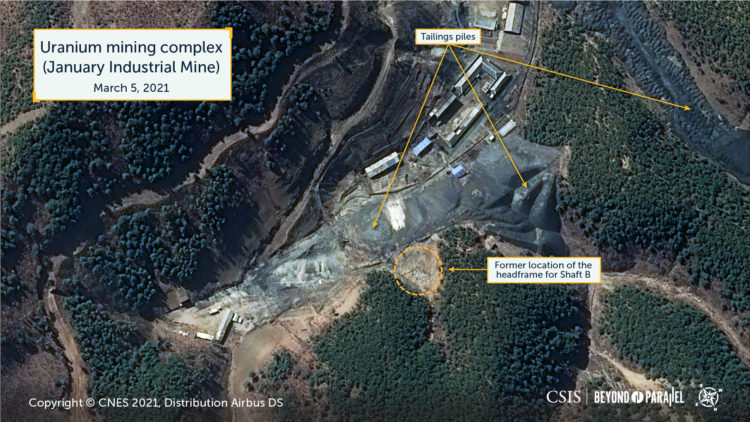

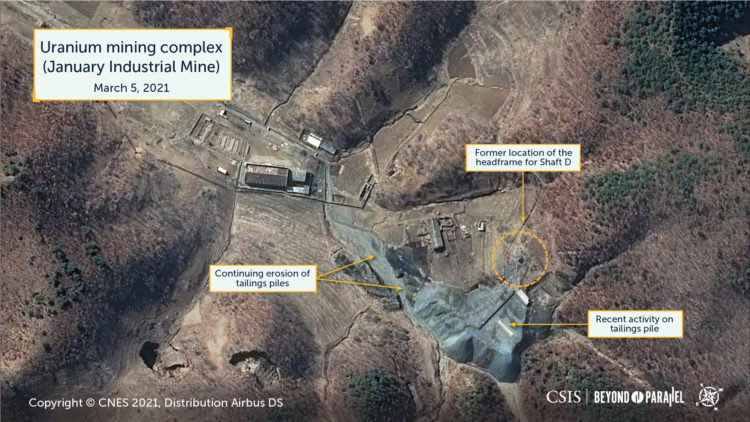
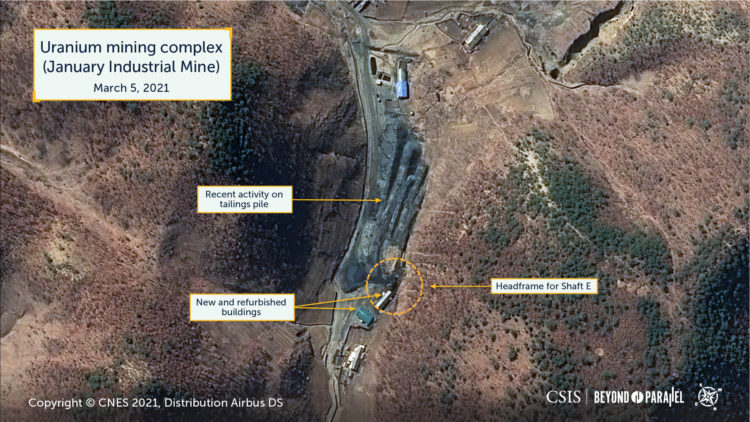
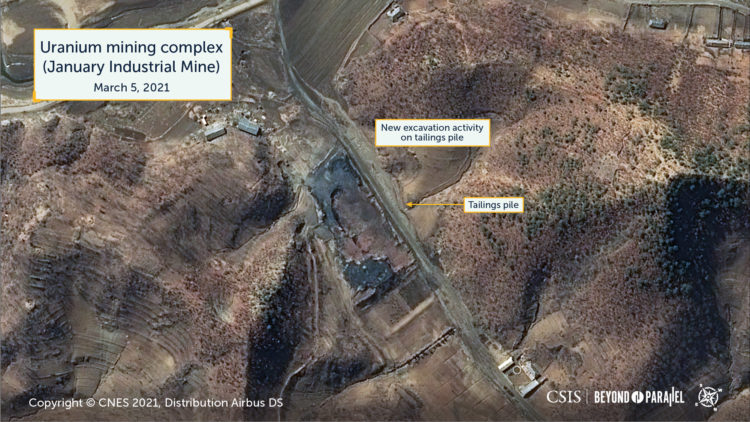
Research Note
This report is part of a comprehensive long-term project undertaken by the Korea Chair at the Center for Strategic and International Studies to use satellite imagery, interview data, declassified documents and open-source information to identify and document the organization, development, operations and status of North Korea’s nuclear program. It is based in part upon a study of North Korea’s nuclear program and infrastructure begun by Joseph S. Bermudez Jr. in 1988 and now continued by the Korea Chair. Various parts of the original study were subsequently published by the author over the years. The information presented here supersedes or updates these and other previous works by the author and the Korea Chair on these subjects.
